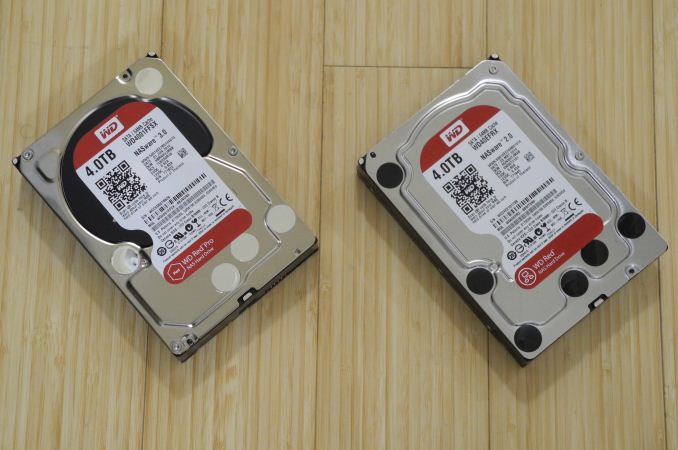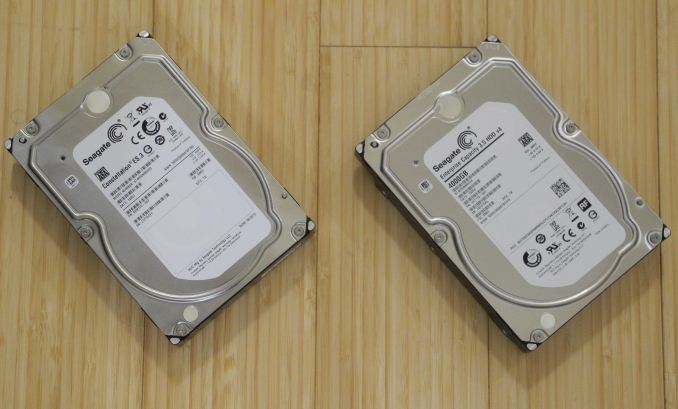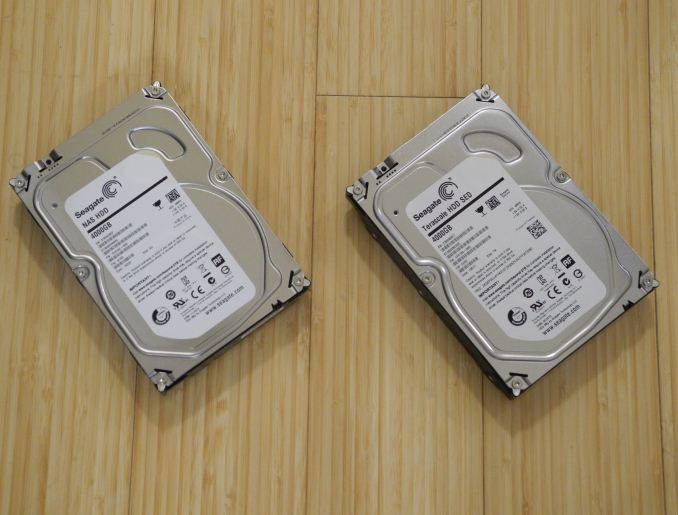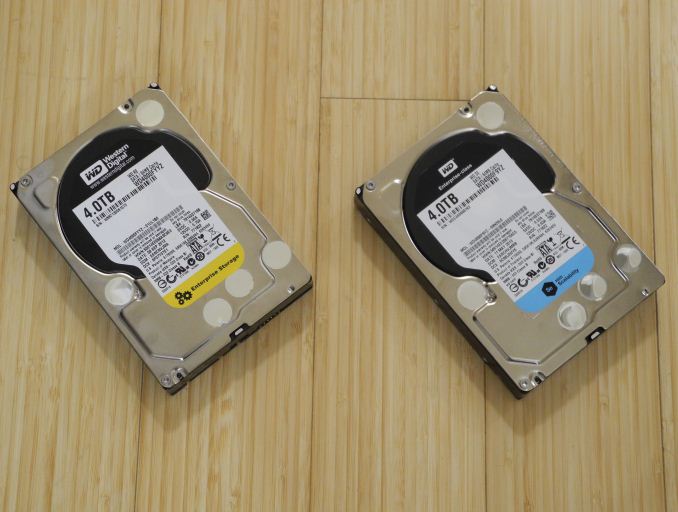WD Red Pro Review: 4 TB Drives for NAS Systems Benchmarked
by Ganesh T S on August 8, 2014 9:00 AM EST4 TB NAS and Nearline Drives Face-Off: The Contenders
Prior to getting into the performance evaluation, we will take a look at the special aspects and compare the specifications of the ten drives being considered today.
Western Digital Red Pro 4 TB
The Red Pro is meant for 8-16 bay SMB / SME rackmount units. Compared to the WD Red, it has better performance, thanks to its 7200 RPM rotational speed. While the WD Red has utilized 1 TB and 1.2 TB / platter configurations, the Red Pro units have 600 GB and 800 GB platters for the 2 / 3 TB versions and the 4 TB version respectively. The lower areal density platters have been in production for quite some time, allowing Western Digital to use a more mature configuration for the Red Pro parts. Like the enterprise drives, the Red Pro comes with hardware-assisted vibration compensation, undergoes extended thermal burn-in testing and carries a 5-year warranty.
Western Digital Red 4 TB
The 4 TB WD Red that we evaluated for this piece is the same as the one that we used in last year's roundup, i.e, the NASware 2.0 version and not the NASware 3.0 version. Even though the WD Reds initially targeted 1-5 bay systems, NASware 3.0 updates the vibration handling mechanism (firmware / calibration) to enable usage in 1-8 bay units. Despite the firmware not being upgradable for older models, WD is honouring warranties even if the NASware 2.0 drives are used in 6-8 bay units. Other aspects of the WD Red models have already been touched upon in our previous reviews.
Seagate Constellation ES.3 4 TB
The Constellation ES.3 lineup is last year's enterprise play (sixth-generation) from Seagate in this market space. It targets applications where capacity, performance and durability under heavy workloads are primary considerations. The drives have a standard 7200 RPM spindle speed, but differ from other units by having a 128 MB multi-segmented cache on-board (64 MB is the standard nowadays). All models are 512N (i.e, native 512 bytes per sector, enabling usage without performance loss for legacy applications).
Seagate Enterprise Capacity 3.5" HDD v4 4 TB
The Enterprise Capacity 3.5" HDD features Seagate's eighth generation drive technology and retains the 128 MB cache of its predecessor. The main difference is that there are no 512N models (either 4K native for the 6 TB model, and 512 emulated for the others). Seagate happens to be the first to use 1 TB platters for its enterprise drives, and this has enabled the Enterprise Capacity lineup to include 6 TB variants. For this review, we managed to get hold of the 4 TB version. On the basis of paper specifications, it looks to be a very good alternative to the WD Red Pro.
Seagate NAS HDD 4 TB
The NAS HDD lineup goes head-to-head against the WD Red. The slightly higher spindle speeds (5900 RPM vs. 5400 RPM) tends to give it the performance advantage at the cost a slight power consumption penalty. Seagate implements the NAS-specific firmware features as part of the NASworks package. We have looked into various features of the NAS HDD lineup in our previous roundup.
Seagate Terascale SED 4 TB
Seagate also supplied us the Terascale drives for this roundup, since we had the WD Se in our previous roundup. The Terascale (previously Constellation CS) goes head-to-head against the WD Se in all departments - it is meant for applications where scalability / capacity is a primary factor, followed by low power consumption and cost. Both 5900 and 7200 RPM versions are available, but our review units belonged to the former category and came with the Instant Secure Erase feature. Unlike the other Seagate enterprise drives in our review samples, this one comes with 64 MB of cache. Seagate claims lowest power consumption in the enterprise drive category for the Terascale drives.
Western Digital Re 4 TB
The Western Digital Re is meant to go head-to-head with the Seagate Constellation ES.3 and Enterprise Capacity 3.5" HDD v4. The application areas are the same - enterprise applications where performance, reliability and durability under heavy workloads are primary requirements. The Re drives are the highest-performing SATA drives from Western Digital. The Xe drives are a class above the Re, but they are available only in capacities of up to 900 GB and come with a SAS interface only. We have been using Re drives in all our NAS reviews so far.
Western Digital Se 4 TB
The Se drives come from WD's Datacenter Storage Business Unit and meant for applications where scalable storage (i.e, reliable storage which doesn't cost an arm and a leg for scenarios where capacity, rather than performance, is of primary importance). WD uses them in their own datacenter. Like other enterprise drives, they come with a self-encryption option and carry longer warranties. When compared to WD Re, the difference comes in the URE (unrecoverable error rates), MTBF ratings and suggested workloads. Further details can be seen in our launch coverage of the WD Se.
Toshiba MG03ACA400
The MG03ACA400 is Toshiba's highest capacity nearline storage device targeting enterprise applications. The specifications are standard - a 7200 RPM drive with a 64 MB buffer. Toshiba makes it clear that the drives target entry-level servers, storage arrays and RAID systems - There is no emphasis on extreme performance, so it is only fair to expect it to slot with the WD Se and Seagate Terascale drives rather than the Re and Enterprise Capacity ones. The street price (as of the time of this article going live) is similar to that of the Terascale, and this only reinforces our perception.
HGST Ultrastar 7K4000 SAS
The HGST Ultrastar 7K4000 is the odd-one out in our sample set today. We had requested HGST for the SATA version of the 7K4000, as that goes head-to-head with the Re, Constellation ES.3 and the Enterprise Capacity drives, but they only had the SAS interface version available for review sampling. The standout aspect of the Ultrastar lineup is the 2.0 million hours MTBF rating. Comparing SATA and SAS drives are like comparing apples and oranges, but, at least, we have the same 7200 RPM spindle speed and 64 MB buffer like most of the other drives. As mentioned in the previous section, we are only going to look at the RAID-5 performance benchmark numbers for this drive in today's review.















62 Comments
View All Comments
jabber - Friday, August 8, 2014 - link
So actually nothing important. When I see these NAS/Storage articles I just can't help with a lot of eye-rolling at what folks write. Folks spending large amounts of effort and money on data that is of little value to anyone or anything.I best most here would actually get by with a 2TB external USB3 HDD.if they were honest. Oh and that includes the business they work for.
jaden24 - Friday, August 8, 2014 - link
Well, what you are calling unimportant is a very subjective statement. To me, spending large amounts of time, effort and money is extremely worth it. Also, much of it has paid off over time since I have properly implemented good practices. This has allowed me to share a library of movies, tv shows and music with my family in 5 different rooms via XBMC because it is all centrally located.Having done all of that work to offer this content would be a total waste if I didn't take proper measures to ensure it is backed up. Surely, it wouldn't be smart to let an array fail and have to re-encode and format all of that data all over again; now that would take a lot of wasted time and effort.
Besides, a 2TB external HDD would have to be USB3 (possibly with UASP) and hooked to a USB3 controller to achieve decent, multiple streams, but it wouldn't have redundancy. Also, 2TB is only going to hold so many movies. What if you like 400-480p movies, but I prefer 720-1080p movies? All of this comes down to preference, and this alone is what determines each of our own setups to suit our tastes.
sapius1 - Friday, September 26, 2014 - link
I am a professional photographer and generate about 1TB/year of original content (growing each year). I absolutely need more than a 2TB external HDD.m2inor - Saturday, August 9, 2014 - link
It's very easy to legitimately consume more than 200GB on any computer let alone a server:- I believe in having multiple copies of personal docs and media I created: photos, personal videos, emails, installers, projects, etc
- if you have multiple desktops and laptops, each should be backed up
- and don't forget to backup the backup devices :-)
Do that for 30 years, and you'll have quite a collection. Only the inciminating evidence should be deleted on a regular basis.
Oh, and you'll only need that one file a few days after you delete it.
dcaxax - Friday, August 8, 2014 - link
When comparing NAS drives, reliability is by far the #1 concern. Power consumption and noise are also important, but by no means the deciding factor.Testing the WD Red drives (especially given the pretty high failure rates of the plain WD Reds) without saying something about reliability makes the whole article pointless.
IF the drives are reliable, people will chose them over faster, chepaer and probablyn even noisier drivers. If you're going to to do this you needs to test at least 10-20 drives and come up with some kind of torture test to really push them.
jaden24 - Friday, August 8, 2014 - link
This is exactly why I only buy hard drives with 5yr warranties. The length of a warranty tells you a lot about the confidence of a manufacture in their product. When bad luck does arise, (usually around the 3-5yr range), you have a drive that gets replaced with no questions asked. At least that is my experience with WD.cen - Friday, August 8, 2014 - link
Too bad HGST couldn't send the deskstar version.. I bought 4 of them a month ago for my FreeNAS build, excellent drives.bsd228 - Friday, August 8, 2014 - link
Ganesh - can you put some questions out to the manufacturers and write a short article on the relevance of URE? I find it very hard to take this metric seriously when consumer drives are all marked as 'better than 1 in 10^14,' a nice round number that hasn't changed in a decade (forever?). Has there really been no improvement? Are they all really the same? And are enterprise drives precisely 10x better? Unlikely. And what is really different about them?shodanshok - Saturday, August 9, 2014 - link
Hi,We recently discussed the URE thing on the Linux raid mailing list. You can found more info here: http://marc.info/?l=linux-raid&m=1406791003244...
asmian - Saturday, August 9, 2014 - link
1 post is not a "discussion". And while this may be relevant for Linux users, it doesn't help anyone else, perhaps running RAID on Windows or using a NAS, for which some at least of these drives are marketed.In the last discussion on this here, there was mention that ZFS (at least with double parity) can avoid UREs affecting array rebuilds. However, it looks as if Storage Spaces and the new ReFS file system now in Windows 8.1 and Windows Server can achieve the same thing as ZFS with much lower system resources (although it is necessary to bypass the Storage Spaces UI on Windows 8.1 for proper configuration). Can anyone share any experience of using ReFS, since this is quite new and directly challenges the Nas4Free/FreeNas route which requires FreeBSD as an OS? In particular, it makes a single media storage server/HTPC combo a feasible proposition, which might be very useful for many...